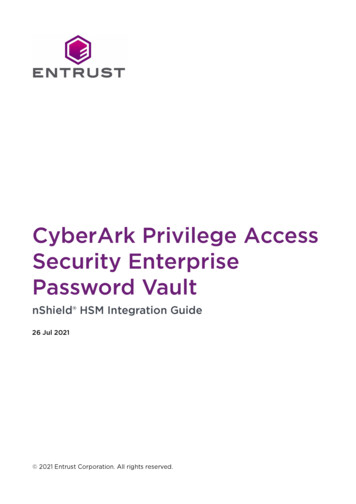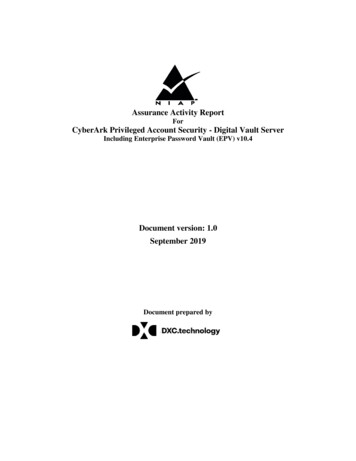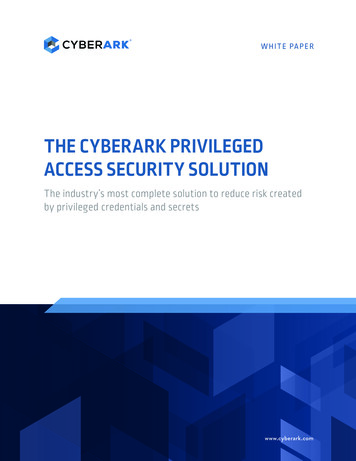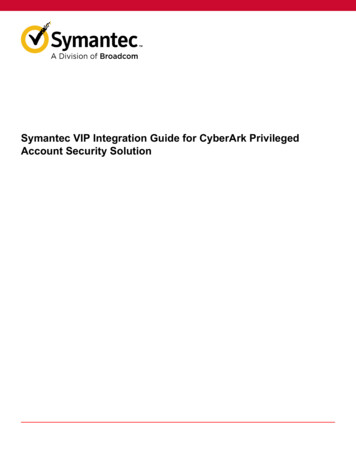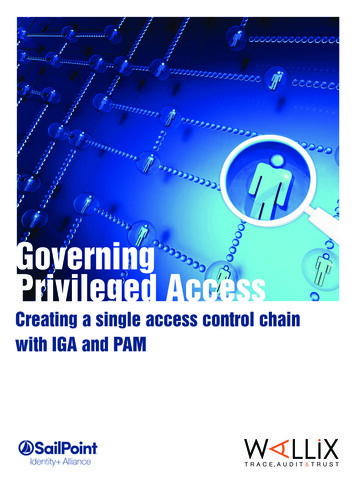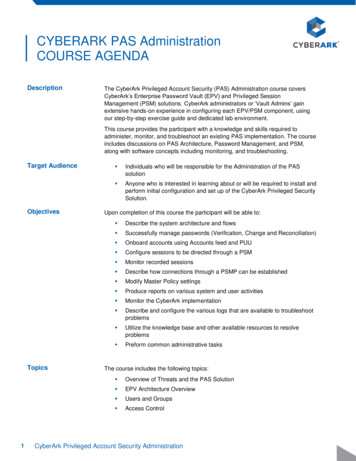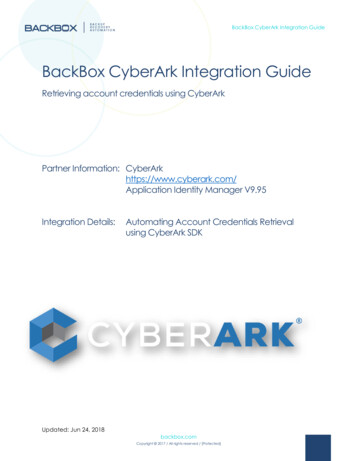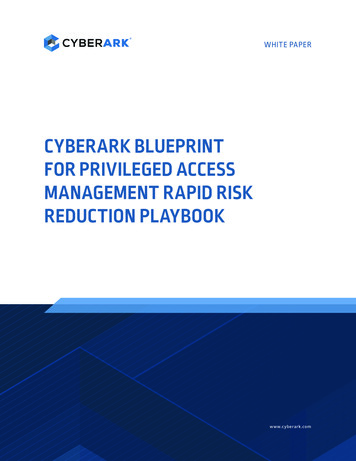
Transcription
WHITE PAPERCYBERARK BLUEPRINTFOR PRIVILEGED ACCESSMANAGEMENT RAPID RISKREDUCTION PLAYBOOKwww.cyberark.com
CYBERARK WHITE PAPERTable of ContentsSummary.3CyberArk Blueprint Helps Reduce Privileged Access Risks .3CyberArk Blueprint Rapid Risk Reduction Playbook Targets Greatest Risk.4Stage One of the Playbook – Secure High-Value Targets. 6Stage Two of the Playbook – Lock Down Most Common Technology Platforms. 6Stage Three of the Playbook – Incorporate PAM into Enterprise Security Strategy. 6Ensuring a Successful Outcome . 6Before the Playbook is Executed.7At the Conclusion of the Playbook.7After the Playbook.7Conclusion. 8Why CyberArk?. 8About CyberArk. 9www.cyberark.comPage 2 of 9
CYBERARK WHITE PAPERSummaryPrivileged accounts are a common target for malicious attackers. Cybercriminals and other bad actors can exploitcompromised privileged account credentials to steal confidential data and disrupt critical IT systems. Businesses muststrengthen privileged access security to reduce risks, but implementing an effective privilege access managementprogram—identifying weaknesses, evaluating potential exposure, introducing new security controls—can be a dauntingproposition for many organizations.CyberArk’s Blueprint for Privileged Access Management Success is specifically designed to help businesses improve theirsecurity posture and mitigate risk in a methodical and efficient manner using field-proven measures. The CyberArk BlueprintRapid Risk Reduction Playbook helps organizations quickly implement the most critical elements of the CyberArk Blueprint torapidly strengthen security and reduce risk. This paper reviews the CyberArk Blueprint and explains how the Rapid Risk ReductionPlaybook can help jumpstart your privileged access management implementation and accelerate risk reduction.CyberArk Blueprint Helps Reduce Privileged Access RisksPrivileged access management is front and center for today’s information technology and security leaders. External attackers andmalicious insiders can gain unauthorized access to privileged accounts and traverse networks to steal confidential information,disrupt critical systems and applications, and impair business. Forrester estimates that at least 80% of data breaches have aconnection to compromised privileged credentials.1CyberArk has developed a prescriptive blueprint to help businesses establish and maintain an effective program to strengthenprivileged access security. The CyberArk Blueprint for Privileged Access Management Success is designed to defend againstthree common moves every perpetrator makes to steal data and disrupt systems. This “thinking like an attacker” approach yields aprioritized, phased implementation plan that closely aligns actions with potential risk reduction.While every organization’s IT environment is unique, adversaries can attack virtually any business by: 1) gaining unauthorizedaccess to privileged account credentials, 2) traversing the network looking for high-value targets, and 3) using elevated privilegesto steal confidential information or disrupt services.With that in mind, the CyberArk Blueprint is based on three guiding principles:1. Prevent credential theft2. Stop lateral and vertical movement3. Limit privilege escalation and abuse1The Forrester Wave : Privileged Identity Management, Q4 2018www.cyberark.comPage 3 of 9
CYBERARK WHITE PAPERThree Guiding Principles of the CyberArk BlueprintCyberArk Blueprint Rapid Risk Reduction Playbook Targets Greatest RiskThe CyberArk Blueprint Rapid Risk Reduction Playbook focuses on the highest-priority elements of the CyberArk Blueprint forPrivileged Access Management Success plan, helping you address the most urgent requirements in the shortest possible time.Later on, you can implement more elements of the CyberArk Blueprint for less-urgent use cases.The Playbook adheres to incident response best practices recommended by leading authorities such as the U.S. National Instituteof Standards and Technology in the NIST Computer Security Incident Handling Guide, the European Union Agency for Networkand Information Security in the ENISA Good Practice for Incident Management publication, and the Australian Cyber SecurityCentre in the ACSC Strategies to Mitigate Cyber Security Incidents. For example, the Playbook addresses the preparation;detection & analysis; and containment, eradication & recovery phases of the NIST incident response life cycle, as shown below.INCIDENT RESPONSE LIFE CYCLEPreparationDetection &AnalysisContainmentEradication& RecoveryPost-IncidentActivitySource: NIST Special Publication 800-61 Revision 2www.cyberark.comPage 4 of 9
CYBERARK WHITE PAPERThe Playbook helps you improve preparedness by proactively securing access to the most frequently targeted privileged accounts.And it helps you identify compromised accounts, isolate attackers and establish corrective measures by analyzing privilegedsession activity. For example, say a privileged account was used to initiate an attack. If the compromised account was vaulted, youcould determine who had access to the account and which systems they accessed, and use that information to potentially mitigatethe attack. If the account was not vaulted, you could examine similar accounts throughout the enterprise to detect and isolatepotential breaches. You could also expand the scope of your privileged access security plan to cover the at-risk accounts.The Playbook helps you address the containment, eradication, and recovery phases of the incident response life cycle. Oncecompromised accounts and/or privileges have been identified, they can be vaulted with one-time passwords and exclusive accountoptions. This prevents the credentials from being used to further the attacker’s objectives.You can also address the containment, eradication, and recovery phases of the incident response life cycle by removingcomponents the attackers used during the incident. For instance, you could disable or delete breached accounts, introduce proxybased access to critical systems and expand privileged account monitoring across the enterprise.The CyberArk Blueprint defines a five-stage, prioritized privileged access management program framework that aligns programmilestones with risk reduction potential. The Playbook focuses on the first three stages of the blueprint, honing in on the mostfrequently targeted accounts, which represent the greatest potential risk, as highlighted in the table below. The Playbook adheres tothe blueprint’s guiding principles, helping prevent credential theft, stop lateral and vertical movement, and limit privilege escalation.CyberArk Blueprint Stages 1-3 with Playbook Objectives HighlightedPAM CONTROLS & TECHNOLOGIESGOALSTAGE 1STAGE 2FoundationalPrivileged AccessManagementLeast PrivilegeApp SecretsManagementSecure privileged IDs withIaaS admins, Domain3rd Party Securitythe potential to control anadmins, VM &Tools such asentire environmenthypervisor, Windowsvulnerability scannersServer local, MFA(via C3 integrations)Focus on locking down theCI/CD consoles3rd Party Businessmost universal technologyWorkstation LocalTools such as withplatformsAdmin, Privileged ADRobotic Processusers, *NIX rootAutomation platforms(via C3 integrations)STAGE 3Build privileged accessCred boundaries, *NIXsecurity into the fabric ofroot similar, 3rd Partyenterprise security strategyVendors, out-of-bandand application pipelinesaccess, database built-IT admin workstationsDynamic Appsin adminswww.cyberark.comPage 5 of 9
CYBERARK WHITE PAPERThe Playbook is intended to implement the most-critical security controls as quickly as possible. Many organizations executethe Playbook in 30 to 60 days. Some take longer. In practice, the Playbook duration is dependent upon an organization’s size,complexity, maturity, culture, and sense of urgency. In the aftermath of a breach, or in other instances when business leaders havean urgent desire to strengthen security, corporate politics are often set aside, bureaucracy is often overturned, and companiesare often able to accelerate security initiatives and some of the later-stage Blueprint recommendations can be pulled into thePlaybook objectives.Stage One of the Playbook – Secure High-Value TargetsIn the first stage of the Playbook, focus on securing high-value targets that represent the greatest potential risk to the business.Identify and secure any privileged accounts that can be exploited to control an entire environment, such as domain admin and IaaSadmin accounts. Prevent unauthorized access and reduce risk by isolating privileged sessions, vaulting and rotating passwords,employing multifactor authentication, and intelligently monitoring and analyzing privileged session activity. Stop lateral andvertical movement by vaulting and rotating passwords and isolating Windows Server local admin accounts in both on-premisesand cloud environments.Stage Two of the Playbook – Lock Down Most Common Technology PlatformsIn stage two, lock down the most commonly deployed technology platforms. Secure privileged on-premises, cloud-hosted andcloud-federated Active Directory accounts used to administer servers and workstations by vaulting and rotating passwords, andby isolating privileged sessions.Stage Three of the Playbook – Incorporate PAM into Enterprise Security StrategyIn stage three, reduce privilege escalation risks by implementing OS-level least-privileged access controls for workstations,laptops, desktops, and virtual desktop instances (VDIs). Endpoint privilege management solutions help you limit exposure byremoving local administrative rights from endpoints and tightly controlling user and application permissions based on policy. Byenforcing the principle of least privilege—granting users the minimum set of privileges required to perform their jobs—you canprevent vertical movement and improve your security posture. And by instituting application controls—preventing ransomwareand other malware, and restricting the operation of unsanctioned applications—you can reduce risk and uncertainty.Ensuring a Successful OutcomeImplementing a comprehensive, enterprise-wide privileged access management program is a process, not an event. The Playbookis a critical first step in your overall privileged access security journey. To ensure a successful outcome you must properly preparefor the Rapid Risk Reduction initiative and you must continuously extend the breadth and depth of your defenses after thePlaybook is executed.Also keep in mind the CyberArk Blueprint is structured to defend against the most common threats posing the highest risk to thebusiness. Every customer’s situation is unique. If you are executing the Playbook in response to a cyberattack, you may need toadjust priorities and re sequence tasks to address your specific circumstances. For example, if you detect the privileged credentialson a universal technology platform (e.g. a local admin account on a workstation) have been compromised such as, you may needto isolate, vault and rotate those credentials while applying the principle of least privilege across all local admin workstations.Over time you’ll need to fully implement all five stages of the CyberArk Blueprint for ultimate security.www.cyberark.comPage 6 of 9
CYBERARK WHITE PAPERBefore the Playbook is ExecutedBefore carrying out the Playbook, do some upfront planning to identify stakeholders, project team members, and the hardwareand software resources you’ll need for the program. Create a project plan defining the specific privileged access security controlsand technologies you plan to implement. Define success criteria and the tools and methods you will use to evaluate progress andmeasure success.At the Conclusion of the PlaybookConduct a postmortem after the Playbook has been executed. Identify what went well and what processes need to be improvedgoing forward. Use lessons learned from the effort to establish ongoing privileged access security systems and practices. Developa formal plan to carry out regular privileged access security enhancements to improve the depth and breadth of your defenses.Prepare a concluding report for executives and business leaders explaining how the Playbook will help the company improvecybersecurity and reduce risk. Describe additional steps and investments required to further bolster security. Present risk inmeaningful, relatable terms like business downtime, lost revenue, or regulatory penalties.After the PlaybookCyberArk customers are also encouraged to arrange a Blueprint session to get additional support in designing and structuringa roadmap to extend privileged access controls across the organization. Now that the most critical and time-sensitive aspectsof the Blueprint framework have been addressed, you can expand the scope of your privileged access security plan. Start byimplementing the outstanding controls and technologies from Blueprint stages 1 – 3, as highlighted in the table below. Continue tostrengthen your security posture over time by instituting stages 4 and 5 of the framework as shown below.Continuously assess the effectiveness of your cybersecurity plan and make adjustments as needed. Execute penetration tests orcarry out red team-blue team exercises to test defenses. Use network scanning tools to identify weaknesses and improve yoursecurity posture. Revise the plan and reprioritize security measures when appropriate.www.cyberark.comPage 7 of 9
CYBERARK WHITE PAPERPost-Playbook ActivitiesPAM CONTROLS & TECHNOLOGIESGOALSTAGE 1STAGE 2FoundationalPrivileged AccessManagementLeast PrivilegeApp SecretsManagementSecure privileged IDs with theIaaS admins, Domain3rd Party Securitypotential to control an entireadmins, VM &Tools such asenvironmenthypervisor, Windowsvulnerability scannersServer local, MFA(via C3 integrations)Focus on locking down theCI/CD consoles3rd Party Businessmost universal technologyWorkstation LocalTools such as withplatformsAdmin, Privileged ADRobotic Processusers, *NIX rootAutomation platforms(via C3 integrations)STAGE 3Build privileged accessCred boundaries, *NIXsecurity into the fabric ofroot similar, 3rd Partyenterprise security strategyVendors, out-of-bandand application pipelinesaccess, database built-IT admin workstationsDynamic AppsStatic Appsin adminsSTAGE 4Mature existing controlsWeb Apps (Top),Windows Servers, Alland expand into advancedBusiness Apps (Top),Workstationsprivileged access securityNetwork & InfraAdmins, Named DBASTAGE 5Look for new opportunitiesWeb Apps (All),Windows Servers, *NIXto shore up privileged accessBusiness Apps (All),Serversacross the enterpriseMainframe Admins,Static Apps (Adv)Windows ServicesConclusionMalicious insiders and external attackers can exploit privileged accounts to steal confidential data or disrupt critical applications.The CyberArk Blueprint Rapid Risk Reduction Playbook helps you identify and mitigate the privileged access security liabilitiesposing the greatest potential risk to your organization as rapidly as possible. Following the recommendations and guidelines of theCyberArk Blueprint, the Playbook can help you rapidly mitigate a malicious attack, data breach, or other urgent security incidents.Why CyberArk?The CyberArk Blueprint reflects the combined knowledge and experience of CyberArk’s global Sales, Sales Engineering, SecurityServices and Customer Success organizations. As the undisputed leader in privileged access management, CyberArk is uniquelypositioned to deliver a thorough and effective privileged access management blueprint: CyberArk solutions are trusted by 5,000 customers, including more than 50% of the Fortune 500, across a wide range ofindustries including financial services, insurance, manufacturing, healthcare, and tech.www.cyberark.comPage 8 of 9
CYBERARK WHITE PAPER CyberArk’s Incident Response and Red Team have been front and center in helping companies recover from some of thelargest breaches of the 21st century. And CyberArk offers the industry’s only Threat Research and Innovation Lab. CyberArk Security Services, Customer Success, and PAS Program Office organizations have decades of real-worldimplementation and support experience, and have a detailed, first-hand understanding of privileged access managementrisks and best practices. Leading research and advisory firms recognize CyberArk as a privileged access management leader for both completeness ofvision and ability to execute.About CyberArkCyberArk is the global leader in privileged access security, a critical layer of IT security to protect data, infrastructure and assetsacross the enterprise, in the cloud and throughout the DevOps pipeline. CyberArk delivers the industry’s most complete solutionto reduce risk created by privileged credentials and secrets. The company is trusted by the world’s leading organizations, includingmore than 50 percent of the Fortune 500, to protect against external attackers and malicious insiders. A global company, CyberArkis headquartered in Petach Tikva, Israel, with U.S. headquarters located in Newton, Mass. The company also has offices throughoutthe Americas, EMEA, Asia Pacific and Japan.To learn more about CyberArk, please visit www.cyberark.com. Copyright 1999-2020 CyberArk Software. All rights reserved. No portion of this publication may be reproduced in any form or by any means without theexpress written consent of CyberArk Software. CyberArk , the CyberArk logo and other trade or service names appearing above are registered trademarks (ortrademarks) of CyberArk Software in the U.S. and other jurisdictions. Any other trade and service names are the property of their respective owners.CyberArk believes the information in this document is accurate as of its publication date. The information is provided without any express, statutory, or impliedwarranties and is subject to change without notice. U.S., 07.20 Doc. 112413THIS PUBLICATION IS FOR INFORMATIONAL PURPOSES ONLY AND IS PROVIDED “AS IS” WITH NO WARRANTIES WHATSOEVER WHETHER EXPRESSED OR IMPLIED,INCLUDING WARRANT Y OF MERCHANTABILIT Y, FITNESS FOR ANY PARTICULAR PURPOSE, NON-INFRINGEMENT OR OTHERWISE. IN NO EVENT SHALL CYBERARKBE LIABLE FOR ANY DAMAGES WHATSOEVER, AND IN PARTICULAR CYBERARK SHALL NOT BE LIABLE FOR DIRECT, SPECIAL, INDIRECT, CONSEQUENTIAL, ORINCIDENTAL DAMAGES, OR DAMAGES FOR LOST PROFITS, LOSS OF REVENUE OR LOSS OF USE, COST OF REPLACEMENT GOODS, LOSS OR DAMAGE TO DATAARISING FROM USE OF OR IN RELIANCE ON THIS PUBLICATION, EVEN IF CYBERARK HAS BEEN ADVISED OF THE POSSIBILIT Y OF SUCH DAMAGES.www.cyberark.comPage 9 of 9
Privileged accounts are a common target for malicious attackers. Cybercriminals and other bad actors can exploit compromised privileged account credentials to steal confidential data and disrupt critical IT systems. Businesses must strengthen privileged access security to reduce risks, but implementing an effective privilege access management
